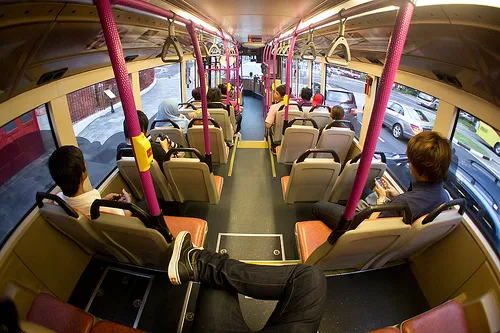
What’s missing from today’s fare adjustment formula?
These two factors missed out from last revision made in 2008 could make a big difference to make the fare adjustment formula fair.
Singapore Business Review spoke with Anthony Chin, an economist from the National University of Singapore to get his view on the recent announcement that the government has formed a new committee to review the country’s fare formula.
Here are his views:
The committee to review the fair formula is done periodically so that's nothing new. Whatever the session is, it doesn't matter because it is something that is due for renewal frequently. That's not a surprise. As far as the formula goes, it's something to say that you should do this or you should do that. But the thing is, can you do it? Or, do you have the information to do it?
So, my take on this whole thing is that, in order for the new committee to decide on factors to consider in the fare adjustment, it’s important for them to know all the details, because we don’t want them to just speculate.
Details that they must be keen of are the following:
1. Cost index
It is safe to say that the formula must reflect the cost index to reflect selling or the cost of providing the service. For just like any other, whether hotel, or if you're selling food or goods for that matter, as you know, the cost is very important. From the business perspective, I need to recover my cost. So there must be a cost index.
The moment the index was used in CPI - CPI reflects the general price in the economy - it did not reflect accurately the cost pertaining to the provision of transport. So this is something that can be improved on.
There are some kinds of a cost index for fare, i.e. CPI includes cost, the price of goods and services, housing rental, and a lot more that push up the CPI to 5.2 or 5.4%. If we’re talking about a public transport, why are you using the CPI which is heavily weighted?
I think, having the sense of transparency is very important. If you are evaluated on your performance bonus, you want to make sure you are evaluated fairly. So similarly for the public, if any fare formula is to be used or to be revised then it should be accurately and transparently reflect what the cost of providing the service is.
2. ROTA for transport operators
There is this thing called productivity. Most companies have to face the share holders. They have to make sure that they are able to be productive, and this of course translates to costs. If i can do more with less people, that will be fantastic as I'd be spending less. So, this is something that should be also reflected best. The current formula has this productivity thing which it says is to be between the operator and the public but my point is that any productivity gain must be reflected in the cost.
You and I don’t work for nothing. We work for incentives and we are not running a monastery and I am not running a charity. I’m running an entity which I have to show at the end of the day (1) to the share holder that I am making money for them and (2) to the public that I am able to provide a service which satisfies you. So unless you are selling Gucci or whatever, LV or whatever, I can sell you at a very high price and you still continue to buy because these are quality stuffs. Public transpo though is not Gucci, it is something that you and I take because you want to move from point A to point B. It's not something that we want to be seen carrying around into, but it is something of a necessity or a need. Therefore, if I’m going to provide this, if I have to please you, in the sense that I’ve to get you from point A to point B very quickly, I also have to please myself. The fare formula should also reflect a return.
The government is using this term called ROTA (rate of return on total assets) and tries to compare this with other similarity. You look at the books of the SMRT and SBS Transit and you see the rate of return but the question is, is this an appropriate rate of return for similar time of operations? If I’m going to review a journalist for instance, I’ve to benchmark one against another reporter of the same experience and the same background. I cannot go and benchmark a reporter against somebody who has got 25 years of experience. So the fare formula should also reflect this: the most accurate recession of the cost index and capture a return fare.



![SBR 5 Lorem Ipsum News 2 [8 May]](https://cmg-qa.s3.ap-southeast-1.amazonaws.com/s3fs-public/styles/exclusive_featured_article/public/2025-05/a_hand_pointing_to_a_futuristic_technology_5b87c9d0e3_3.png.webp?itok=M3Hf-9XR)
![SBR 4 Lorem Ipsum [8 May Top Stories]](https://cmg-qa.s3.ap-southeast-1.amazonaws.com/s3fs-public/styles/exclusive_featured_article/public/2025-05/a_hand_pointing_to_a_futuristic_technology_5b87c9d0e3_2.png.webp?itok=2m5Wl0MX)


![Exclusive three SBR 12 Lorem Ipsum [8 May]](https://cmg-qa.s3.ap-southeast-1.amazonaws.com/s3fs-public/styles/exclusive_featured_article/public/2025-05/a_hand_pointing_to_a_futuristic_technology_5b87c9d0e3_11.png.webp?itok=8kn_UIfA)
![SBR 3 Lorem Ipsum [ Exclusive 2]](https://cmg-qa.s3.ap-southeast-1.amazonaws.com/s3fs-public/styles/exclusive_featured_article/public/2025-05/a_hand_pointing_to_a_futuristic_technology_5b87c9d0e3_1.png.webp?itok=YCyjLegJ)
![SBR 2 Lorem Ipsum [8 May]](https://cmg-qa.s3.ap-southeast-1.amazonaws.com/s3fs-public/styles/exclusive_featured_article/public/2025-05/a_hand_pointing_to_a_futuristic_technology_5b87c9d0e3_0.png.webp?itok=_cKD-29o)

![Video [Event News]](https://cmg-qa.s3.ap-southeast-1.amazonaws.com/s3fs-public/styles/event_news_featured_article/public/2025-05/screenshot-2025-05-08-at-4.58.53-pm_0.png.webp?itok=Kud35sMs)
![Event News SBR 9 Lorem Ipsum [8 may]](https://cmg-qa.s3.ap-southeast-1.amazonaws.com/s3fs-public/styles/event_news_thumbnail/public/2025-05/a_hand_pointing_to_a_futuristic_technology_5b87c9d0e3_8.png.webp?itok=DTh_dbYp)
![Event News SBR 9 Lorem Ipsum [8 May]](https://cmg-qa.s3.ap-southeast-1.amazonaws.com/s3fs-public/styles/event_news_thumbnail/public/2025-05/a_hand_pointing_to_a_futuristic_technology_5b87c9d0e3_7.png.webp?itok=vzDAzb6V)
![Event News SBR 8 Lorem Ipsum [8 May]](https://cmg-qa.s3.ap-southeast-1.amazonaws.com/s3fs-public/styles/event_news_thumbnail/public/2025-05/a_hand_pointing_to_a_futuristic_technology_5b87c9d0e3_6.png.webp?itok=jvHFc4P6)
![Video [Event News]](https://cmg-qa.s3.ap-southeast-1.amazonaws.com/s3fs-public/styles/video_thumbnail/public/2025-05/screenshot-2025-05-08-at-4.58.53-pm_0.png.webp?itok=yZnI0YBb)
![Video 1 SBR [8 May]](https://cmg-qa.s3.ap-southeast-1.amazonaws.com/s3fs-public/styles/video_thumbnail/public/2025-05/screenshot-2025-05-08-at-4.58.53-pm.png.webp?itok=9AAeRz_k)

 Advertise
Advertise

